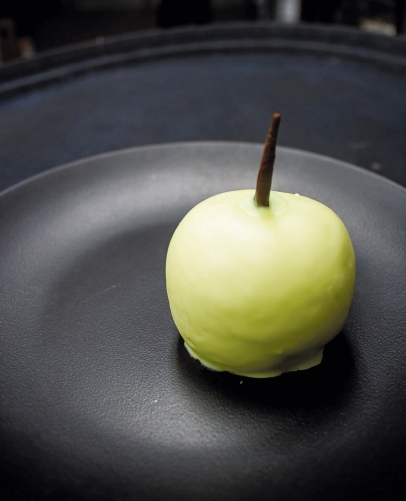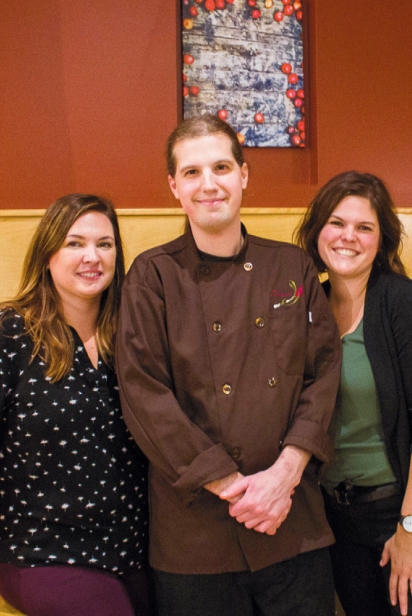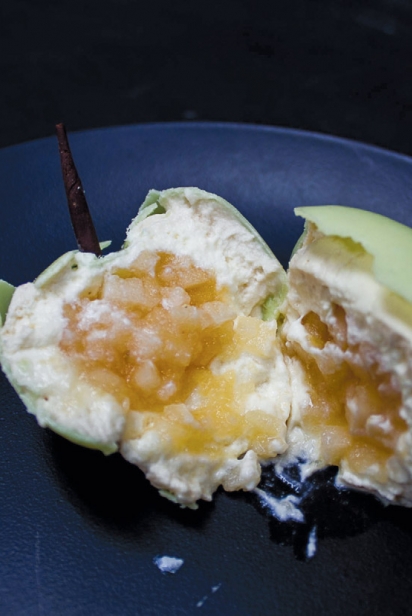Dinner at Terrain
Chef Randy Minish has been dreaming about this dinner for a decade. When he worked, as a very young man, in this exact space, when it was Lulu’s Bistro, he thought about it. When he worked at Moka down the street, when he went to Great Lakes Culinary Institute, he thought about it. When he worked at various restaurants both in Michigan and in California, Randy Minish dreamed about apples, developing the menu that is before me tonight at Terrain, the restaurant he opened earlier this year in downtown Bellaire.
As I sit at one of the community tables, simply and beautifully set for the “Apples vs. the World” theme dinner, I am struck by the tenacity that it takes to have a big long ten-year dream, and how it must feel to be realizing that dream, tonight, in his own place.
I take a seat across from Barb Tholin, editor and friend. The tables fill up quickly and we meet the folks we will be dining with. To my right is Larry McSweeney-Steffes from Danu Hof Farm in nearby Mancelona, where the third-course pork belly came from. To my left is J.P. Kent from Tandem Ciders, one of the cideries represented during the evening’s paired offerings. Kitty-corner from me is Elizabeth Kantzer from Bee Well Mead & Cider just down the street, who also provided a cider—one with sumac in it—for one of the course pairings. Knowing who and how these dishes and drinks got to be on the menu makes everything taste just a little bit better.
Terrain opened in the spring of 2019, a family affair from the start. Partnering with Randy, 33, is his older sister, Shana, who runs the books and carefully prepares the wine lists-—in addition to becoming a Marine, she once trained as a sommelier. The general manager is their younger sister, Jenna, who runs the front of the house and sees to the day-to-day tasks of running a restaurant. Both sisters also worked previously in this same building, back when it was the well-loved Lulu’s Bistro, run by Chef Michael Peterson.
Tonight, Jenna and Shana each stands up and tells us a little about this new restaurant and the meal we are partaking of, and as each course is delivered we are entranced by each dish, prepared so lovingly and so delicious. The tiny apple-leek custard pie that comes out first has some of the best pastry I have ever eaten. The third course of Flynn Orchards smoked apple butter with Danu Hof pork belly and crispy Brussels sprouts was a favorite of many folks at our table. The apple-stuffed turkey breast was enhanced by a flavorful parsnip sauce and local chestnut mushrooms. Not one of the courses has cinnamon in it, an uncommon way to address an apple-based fall repast, and a choice carefully curated by the chef.
Chef Minish has developed a bit of a reputation for his ice cream, and tonight he sends out a light and airy sorbet of mixed apples to clear our palates for the final course, called, simply, An Apple—so secret and hush-hush that I am not allowed into the kitchen to take a photo until I have sat at the table and been part of the surprise.
On the charcoal-colored plates being delivered around me I see only a light green apple. Each person delights in discovering that this is a tinted white-chocolate-encased orb, full of apple-brandy-infused white chocolate mousse surrounding a core of jam made with Cox Orange Pippens, an heirloom variety provided by Jeremy VanSice of Bee Well. The apple stem is a perfect piece of chocolate. A visionary dessert, exquisitely prepared.
Chef Minish and his kitchen team come out and take a bow, and he visits with everyone, mingling with guests and friends, both old and new. He loves this place, both for the old and the new.
The dream has become real.
Chef Randy Minish: This is my second special-event dinner. The first was a harvest dinner, and each course was based around a farm that I work with. So after the course came out they could stand up and say, “Hey, I’m Kelly from Daybreak Farm. Here’s what we do. Here’s the produce.” And today it’s about apples first … The cideries involved have people here who will talk about their cider. One of the things I love about doing these events is I get to not take all the credit. I get to give some other people some space to be as influential, I guess, as they have been to me.
Edible Grande Traverse: Even the coffee is delicious. I love to have coffee post meal but if you are served underwhelming coffee at the end of a delicious meal, then it just makes the whole night sag a little. You’re either a great restaurant or you’re not by the coffee that you serve.
Chef: I feel similarly and the fact is that we who work in this restaurant will be drinking plenty of the stuff. I get mine from Mundos Coffee in Traverse City. We do a really simple coffee program. Mundos uses single-origin sourcing, and their passion behind it, that is the important part. Coffee’s an interesting thing, right? Because it can never be truly local.
EGT: So, are you a sustainable restaurateur?
Chef: No, I would not say so. I am not an expert on sustainability but it’s a realm that I’m certainly familiar with.
It’s an issue I kind of struggle with. When you open a restaurant, there are 100 decisions you have to make; 85 of them are probably going to be wrong, or involving things that you wouldn’t completely agree with, right? But if you’re really pig-headed about it like I am, you can probably make 15 really good ones. And, 15 doesn’t feel like it makes up for the other 85 ones, but a lot of people in my shoes are doing 100 bad decisions.
I make New American regionally based cuisine. I am going to serve beef right away, from Michigan Craft Beef, a small farm down near Grand Rapids. Is that sustainable? Because I’m in America, almost every food item I purchase touches plastic at some point, right? And that doesn’t feel super good either. What you realize is, if you’re going to do this, you’re checking into some decisions that you don’t necessarily agree with. However, the state of industry, the state of where we’re at, is that a lot of those things don’t have a solution yet!
EGT: How do you reconcile those conflicts?
Chef: I was talking to a friend about this very issue, Andy Largent, head brewer at The Filling Station in Traverse City.
Andy has a similar point of view. He says what makes him feel most comfortable about it is every year he tracks how much stuff he buys locally within the state of Michigan, and every year he tries to beat that goal, even if it’s just by a percentage or two. Always working toward it … to rebuild those types of infrastructures.
When I had lunch service this summer I had a lamb wrap made with legs of lamb and even in my small 90-seat restaurant I probably sold 50 lambs worth of hind legs in the summer. There is not a small farm around here that can keep up with me on lamb. My lamb footprint is now already too big for this foodshed. I can walk over to Short’s Brewing, they get 1,000 people on the Fourth of July, right? So they have an even bigger footprint. And we’re just two restaurants in a town of 1,000 people.
Yes, if you go out to California, you have fantastic goat cheese but you have to realize that was a 50-year career for people to get to that point. Chez Panisse started with folks smuggling seeds from Europe into the U.S. in their body cavities—they did not just wake up one day and say “Let’s open a local food restaurant with all the great stuff that is here.”
And we in the NoMi foodshed haven’t spent as much time doing that ... but there are so many issues to tackle that people have a lot of options and can have great impacts. Pick a topic—wine, beer, cider, there’s good cheese being made, there’s good produce—all totally being reevaluated and reinvigorated by people with vision.
But the first step, a small step, is just getting people to accept that you can be a restaurant without shrimp or something, right? I mean, there’s so much work to be done and you can take any of it and go any direction. That’s what makes being in Northern Michigan right now such an exciting time to work in food.
EGT: How far out do you plan your menu and is that going to change now with winter coming?
Chef: I haven’t gone through my first winter yet, so I have some questions how it’s going to go, too! Now this was a weird growing year, everything was behind, but generally I’m thinking, “OK, what is the next produce I’m getting?” Then I start bothering my farmers every time I see them. “Hey, turnips up yet? How are the rutabagas?” Once fall hit, I’ve been selling stuffed squash, squash purée, and moving through five or six varieties of organic squash just like crazy.
I’m always thinking a month or so out. I had known I was going to do plum with duck since before I opened. I was just waiting for plums to become available … and now I’m on my last batch of plum sauce for the duck, I got to figure something else out. So it’s driven by seasonality, after that what ingredients can I get excited about?
Then it’s just trying to keep sourcing closer and better ways. And of course, we’re a small restaurant, first season. I can’t do any good unless I pay my bills … but I’m always working on it.
Being regionally focused, being a bit more ethical and such in our supplying, we are real people who are working hard to do that, and while the state of the industry is trying to catch up. Within the constraints of the market we are trying our best to do a local-focused menu in the most authentic way possible.
IF YOU GO:
Terrain
213 N. Bridge St., Bellaire
231-350-7301 • Terrain-Restaurant.com









